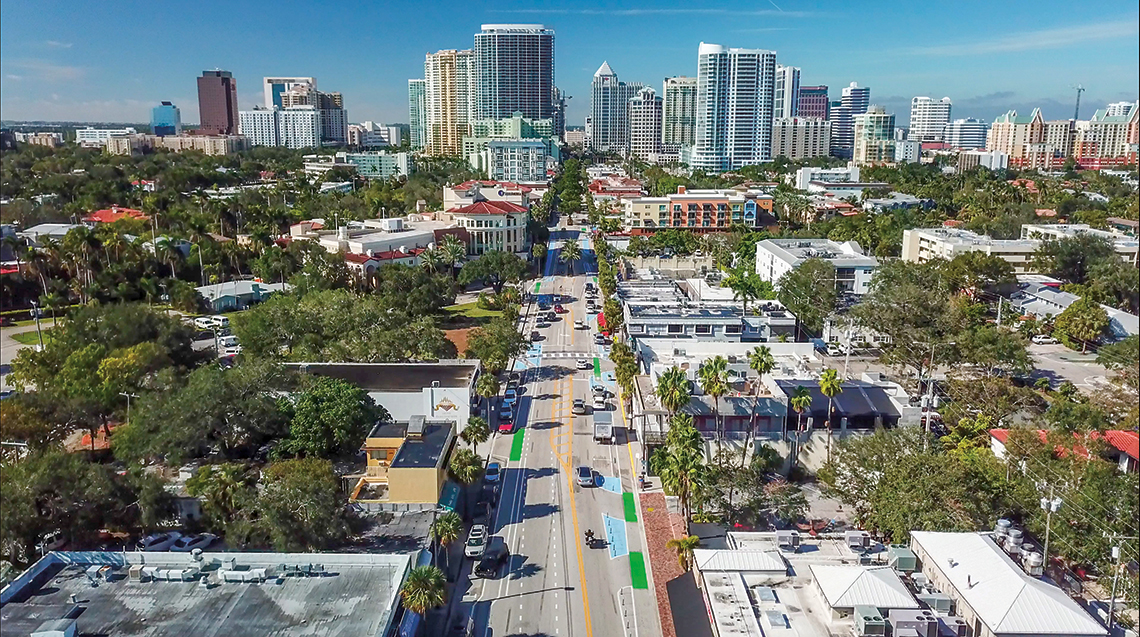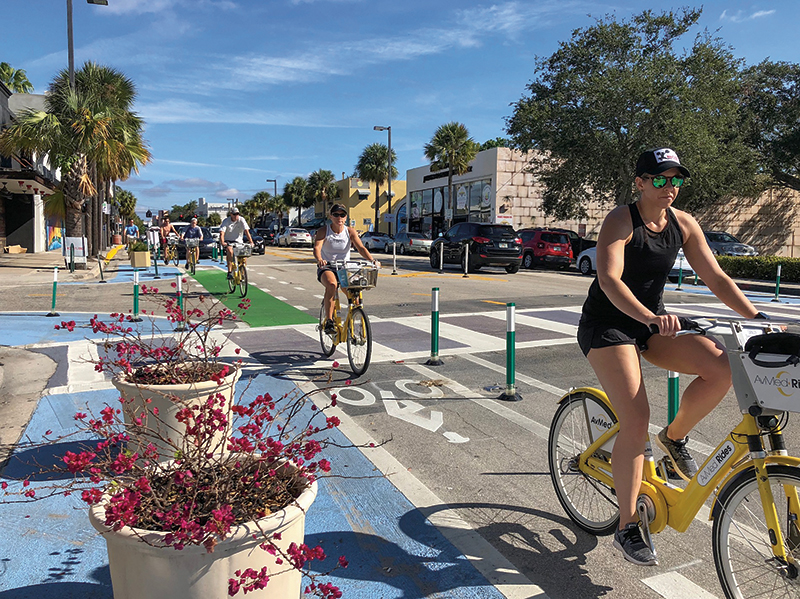
In the past year, a busy section of Las Olas Boulevard had become a lot more colorful. Not in terms of new shops or restaurants, although there have been those too. The actual road itself has added splashes of color – all in the name of safety.
Currently, there are color-coded lanes dedicated to cyclists from Southeast 11th Avenue to Southeast 15th Avenue, the eastern end of Las Olas’ shopping-and-dining district. Some of Southeast 11th is painted green. Another portion of the street is painted blue and the remaining outer lanes are no longer available for drivers. There are small plastic bumpers and plastic poles protecting these lanes and preventing drivers from drifting into them. Pick-up and drop-off zones now exist for rideshare cars and taxies, along with loading zones for deliveries to businesses.
All this is a part of a larger project called Vision Zero, an effort by the city to calm traffic and improve safety for everyone. The “Zero” refers to the project’s goal of no deadly traffic crashes and accidents; other similar changes have been or are being made to other streets around the city. Eventually, leaders hope to see joined-up cycle lanes linking together across the city and beyond. For now, the Las Olas project is a slightly more ambitious pilot program that, if deemed successful, could be implemented in more places.
“There were never any bike lanes on Las Olas,” says Robin Haines Merrill, one of the residents who fought for more safety measures on the street. “Attention started to be paid to them when we saw how bad our national statistics were for death and injury.” A 2015 report from the Department of Florida Highway Safety and Motor Vehicles ranked Broward in the top 10 counties for pedestrian accidents and deaths.
Since being installed last March, the new street features have received mixed reviews – something that was reflected in city surveys.
“About 600 people filled out the surveys regarding the demonstration,” says city commissioner Steve Glassman, whose District 2 ends just north of this stretch of Las Olas. “We got a lot of mixed reactions, but the result of that is Vice-Mayor Ben Sorensen and I initiated a Las Olas Boulevard Mobility Working group, with stakeholders up and down Las Olas from Andrews Avenue to the beach.”
The group’s goal: one cohesive plan. According to Glassman, there are many plans for different segments of the boulevard. Commission member Sorensen’s District 4 includes the stretch of Las Olas where the new features have been added.
Some see benefit in the additions.
Sonia Terboss, who owns SpaJuiceBar with her husband on Las Olas between Southeast 12th and 13th avenues, believes the bike lanes have drawn an active crowd to her shop. As a cyclist herself, she enjoys the safety they provide.
“You’re less fearful of the traffic and feel a little bit safer,” she says.
Whitney Dutton, a real estate agent and a board member of bike advocacy group BikeWalkFTL, wants the city to become more cyclist-friendly in general and believes Las Olas is a great place to start.
“We need more attention to focus on becoming a cyclist-friendly city,” he says. “We don’t expect them to get everything right, but we do want people to take the issue of bike safety more seriously.
“I think the bike lanes in place are good and the idea is great, but I think they need fine tuning and insight from other cyclists.”
Different cyclists, Dutton says, ride at different experience levels. “The lanes may be safe for me at an experienced level but for average people, people with children or even older people, you have to balance the spectrum when it comes to the safety issue.”
Others question whether the addition of the bike and pedestrian lanes has reduced the amount of vehicle traffic. Luke Moorman, owner of Las Olas business Carroll’s Jewelers and president of the Las Olas Association, says that “less traffic by cars means it’s harder for my customers, which means all of a sudden they are going to go somewhere else.”
Although, Moorman says, he’s heard different views. “My neighbor, on the other hand, says that there are more people walking which means more sales.”
On Las Olas, as in other parts of the city, the plans remain a work in progress. One main goal now is putting forward something consistent.
“There was too much of mishmash of plans that were not connected and didn’t fit the needs of the entire boulevard,” Glassman says. “We try to bring together one plan that meets the needs of all types of mobility and can move forward by consensus by all of the stakeholders along the boulevard.”












